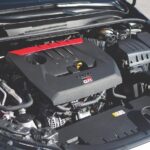Driving on a coffee farm’s dark, gravel roads at low speeds can be challenging, especially when your vehicle’s High Beams refuse to switch on. Many drivers experience a similar issue: the high beams seem to be deactivated below a certain speed, often around 20-25 mph. This can be particularly frustrating when off-roading or navigating dimly lit areas at slower speeds where enhanced visibility is crucial. Let’s explore why your high beams might not be working under 21 mph and what you should know.
The Role of Speed Sensors in Modern Headlight Systems
Modern vehicles are equipped with sophisticated systems designed to enhance safety and optimize performance. One such feature in many newer cars is speed-sensitive headlights. These systems use speed sensors, the same ones that inform your speedometer and anti-lock braking system (ABS), to determine the vehicle’s speed and adjust headlight functionality accordingly.
Alt text: Car headlights illuminate a winding road at night, demonstrating the importance of high beams for visibility in low-light conditions.
Why High Beams Might Be Disabled at Lower Speeds
The decision to deactivate high beams below a certain speed is often a deliberate design choice by vehicle manufacturers, driven primarily by safety considerations and specific driving conditions. Here are a few key reasons:
1. Urban and Low-Speed Environment Optimization
High beams are designed for open roads with minimal traffic to maximize visibility over long distances. In urban settings or residential areas, and when driving at slow speeds, the intense light from high beams can be more of a hindrance than a help. At lower speeds, the area you need to illuminate is significantly reduced. Using high beams in these situations can cause excessive glare for oncoming drivers and pedestrians, reducing overall safety and potentially violating traffic laws.
2. Preventing Glare and Reflection
At slow speeds, especially in off-road or confined environments, there’s a higher chance of encountering reflective surfaces like road signs, buildings, or even the rear windows of vehicles directly in front of you. High beams reflecting off these surfaces can create blinding glare, reducing your own visibility and potentially causing temporary blindness or discomfort to other drivers. By deactivating high beams at lower speeds, manufacturers aim to minimize this risk.
Alt text: Detailed view of a car high beam headlight projecting bright light, illustrating the intensity of high beam illumination.
3. System Design and Intended Use
Vehicle engineers design headlight systems with specific use cases in mind. High beams are intended for situations requiring long-range visibility at higher speeds where reaction times are critical. At lower speeds, standard low beam headlights often provide sufficient illumination for safe maneuvering and obstacle detection in the immediate vicinity of the vehicle. The speed-sensitive feature is a part of this overall design philosophy to ensure optimal headlight performance across different driving scenarios.
Overriding Speed-Sensitive High Beam Limitations
While speed-sensitive high beams are designed with safety in mind, there are situations, like off-roading or navigating very dark private roads, where you might need high beams even at low speeds. Fortunately, many vehicles offer a manual override function. As the original poster mentioned, “if you flip the level towards you ..it does light up the high beams…”. This “flash-to-pass” or manual high beam activation bypasses the speed sensor limitation, allowing you to use high beams momentarily regardless of speed.
For more sustained high beam use at low speeds, especially for off-road enthusiasts, auxiliary lighting solutions like “ditch lights” or front bar lights, as mentioned in the original post, can be excellent alternatives. These aftermarket lights are often independently controlled and can provide the desired wide and long-range illumination without being tied to the vehicle’s speed-sensitive headlight system.
Consult Your Vehicle Manual
The specific behavior of your vehicle’s headlights, including speed-sensitive features, can vary depending on the make, model, and year. For definitive information on your car’s headlight system and how to operate your high beams in different situations, always consult your vehicle’s owner’s manual. It will provide detailed instructions and explanations specific to your vehicle, ensuring you understand and utilize your car’s lighting system effectively and safely in all driving conditions.
By understanding the reasons behind speed-sensitive high beams, you can better navigate low-speed driving situations and make informed decisions about your vehicle’s lighting needs.
